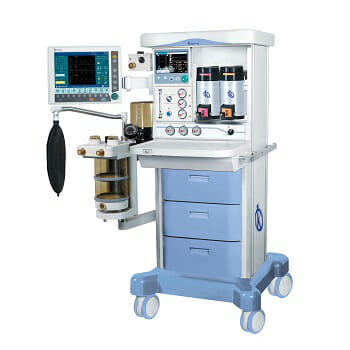The anesthesia machine must be precisely adjusted to ensure the safety and well-being of the patient under anesthesia. An anesthesia machine includes equipment used to administer anesthesia, such as gases or drugs. These machines should be adjusted to administer adequate anesthesia according to the patient’s age, weight, and conditions, as well as any pre-existing medical conditions they may have.
Before starting the procedure, the anesthesiologist, nurse or anesthesia technician will perform a pre-examination to adjust the anesthesia machine to the patient’s condition. Exhaling moist air into the patient’s skin near the nose and mouth is one way the patient is monitored to adjust the correct dose. This is done to monitor the level of oxygen in the exhaled air. Health care practitioners may also monitor vital signs, such as blood pressure, heart rate, and respiratory rate, to check whether the patient is being appropriately anesthetized.
Which parts of the anesthesia machine should be checked?
Usually, the anesthesia team consists of an anesthesia controller, drug pumps, gas pumps, a mechanical ventilator, monitoring equipment, and delivery devices. The safety of all these devices must be verified and tested before use. The anesthesia controller contains systems such as the starter, the control unit, the mixer and a pressure regulator.
All of these systems allow control of the gas mixture administered during anesthesia. The starter is the device that turns the rest of the anesthesia machine on and off. The control unit contains a screen where health care providers can monitor the patient’s vital signs, and based on this information you make the appropriate decisions.
In addition to the controller, drug pumps and gases work together to control the amount and mixture of gas and fluids that are supplied to the patient during the procedure. The gas pump contains a mixture of oxygen and nitrous oxide and provides a constant, monitored dose of anesthesia. The drug pump controls the administration of anesthetic drugs.
Why should the mechanical ventilator be checked?
In addition to anesthetic equipment, staff should check safety devices to avoid harm to the patient during anesthesia. These devices include tube adapters, mechanical ventilators, and devices to measure vital signs. The mechanical ventilator is attached to the anesthetic tube and provides ventilation during anesthesia. These devices should be adjusted to ensure adequate patient pressure.
Respirators also contain devices that control pressure and temperature as well as airflow during the procedure. Mechanical ventilators are also used to monitor the person’s vital signs and alert nurses if there is an unexpected change. Monitors have the ability to measure blood pressure, heart and breathing rates, as well as oxygen saturation. These monitors can also detect any blockage in the anesthetic tubes.
Why is the anesthesia machine important for the patient?
All of these devices are safely adjusted to ensure patient well-being during anesthesia. This helps to avoid any complications related to anesthesia, such as adverse effects, and also ensure that the procedure is completed successfully. Health care practitioners should check anesthesia equipment regularly to make sure it is working properly. Technicians should also use the correct settings to ensure that the patient receives adequate anesthesia.
In summary, anesthesia devices must be precisely adjusted to provide safe and effective anesthesia to the patient. These machines contain the equipment needed to properly administer anesthesia, including the controller, drug and gas pumps, storage devices, mechanical ventilators, and devices to monitor the patient’s vital signs. These kits should be checked and adjusted safely to ensure the safety of the patient under anesthesia.
What Kalstein offers in anesthesia machines
Kalstein anesthesia machines are designed to make this process fluid. In addition to being able to monitor vital signs such as breathing and can regulate oxygen pressure. Further specifications and purchasing details for these items, such as sales, pricing and purchase, are available on the websites HERE and HERE


